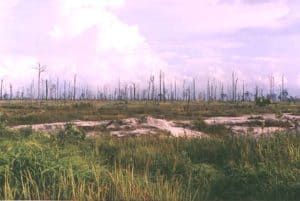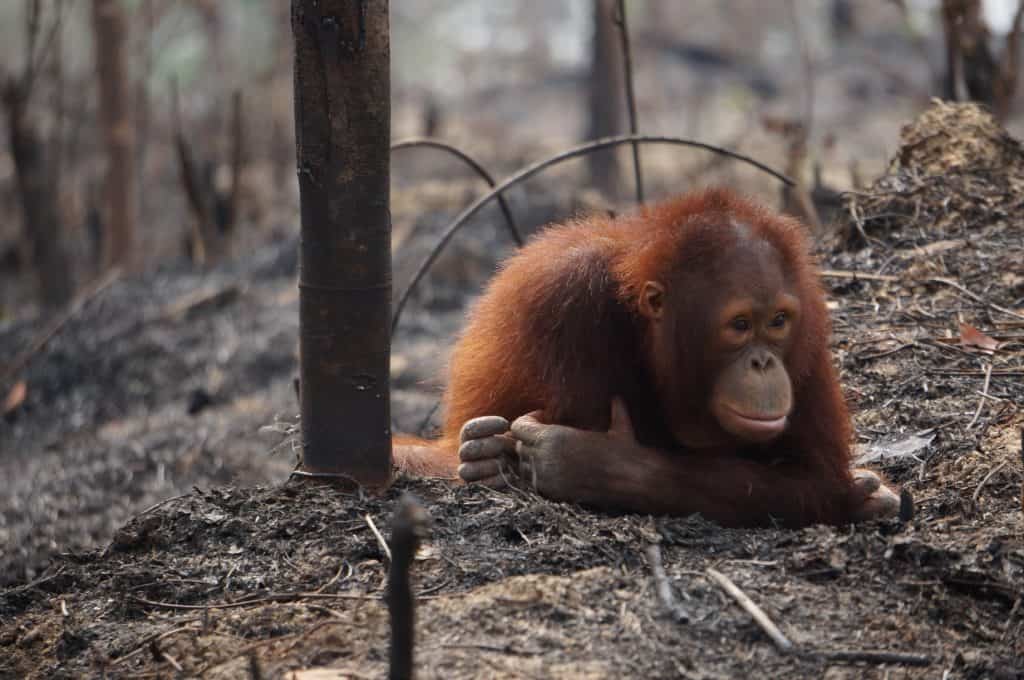On the 6th of May 2019, UN’s nature panel IPBES (The Intergovernmental Science-Policy Platform on Biodiversity and Ecosystem Services) published the most comprehensive and well-documented report to date, investigating the impact of human utilisation and exploitation of nature around the globe. The report warns us that we are currently overseeing the sixth mass extinction – which is man-made this time around. And it comes with serious consequences for vegetation, wildlife, and humanity.
The IPBES report evaluates global man-made changes in nature and biodiversity over the past 50 years, and it has been composed by 145 of the world’s leading scientists with contributions from 310 experts and is based on approximately 15,000 scientific sources and observations. For the first time on such a large scale, the evaluation is also based on local knowledge about nature. The reports’ findings are alarming to put it mildly.
More than 1 million species – including the orangutan – threatened with extinction
Among other findings, the report reveals that more than 1 million of the world’s estimated 8 million existing species are threatened with extinction – including the orangutan. And several of them may even go extinct within decades. The number of endangered species is at record high and is already up to hundreds of times larger than the past 10 million years’ average.
However, according to Forbes Science, the number of species threatened with extinction is likely much higher than the report’s 1 million, since microbes such as bacteria, algae, and fungi were not included in its investigation. Microbes are crucial to the preservation of ecosystems. Among other functions, microbes help decompose dead organic matter, allowing the release of essential nutrients for plants. They can fix nitrogen from the air and prevent depletion, which can lead to desert-like landscapes and impeding vegetation. If such microbes are threatened with extinction too, the situation is much more critical than what the IPBES report finds.
Unfortunately, the report also finds that the rate at which the species go extinct is accelerating and is much more rapid than the extinction that occurs constantly as a natural and evolutionary process in a dynamic world. Sir Robert Watson, IPBES chair, explains that “The health of ecosystems on which we and all other species depend is deteriorating more rapidly than ever.” Our globe has overseen five mass extinctions due to natural factors such as natural disasters. We have now entered the early stages of a sixth mass extinction – this time due to humanity.
More than 1 million plant and animal species are threatened with extinction, and 500,000 species’ habitats, including the orangutan’s, can no longer support them in the long term. Animation from IPBES.
What causes the rapid biodiversity loss?
The report thus paints an ominous picture of the future. The explanation is found in us humans and our utilisation and exploitation of nature – especially over the past five decades.
The report presents five direct drivers of change in nature with the largest global impacts so far:
- Changes in land and sea use.
- Direct exploitation of organisms, e.g. hunting, fishing, mineral extraction, and logging.
- Climate change – although climate change currently ranks as the third most impactful driver of change, the report warns that unless climate change is mitigated, it will become the most impactful driver of biodiversity loss.
- Pollution
- Invasive alien species with negative impacts on original and natural biodiversity.
The drivers of change in nature mentioned above are the results of several indirect drivers, including consumer behaviour, population growth, and a global focus on economic growth at the expense of sustainability.
Despite the fact that the climate crisis is one of several factors in the larger biodiversity crisis, the global society mainly focuses efforts to mitigate climate change, while significantly less efforts to mitigate the biodiversity crisis are initiated. Biodiversity is obviously still the younger of the two siblings. Naturally, it is still extremely crucial to implement serious measures against climate change but it is equally crucial to implement measures against the loss of biodiversity. In light of the report, it is crucial the biodiversity crisis be taken more seriously and recognised as one of the largest threats against both wildlife and vegetation as well as humanity.
The main causes of the biodiversity loss are driven by human utilisation and exploitation of nature and its resources. Animation from IPBES.
What effects does the biodiversity crisis have on us?
Not only is humanity causing the biodiversity crisis, it is also a victim of it. According to professor Settele, the loss of biodiversity “constitutes a direct threat to human well-being in all regions of the world,” since we and all other species are dependent on the ecosystems. Among other things, the ecosystems contribute to nature’s stabilising functions that are absolutely vital to humanity. Our livelihoods are therefore threatened when ecosystems are destroyed.
Our current efforts to reduce our collective footprint by setting global goals, for instance in the Sustainable Development Goals and the Paris-agreement, and our increasing focus on climate and sustainability over recent years are not enough. According to the report, we can no longer meet the global goals set in the Aichi Biodiversity Targets, the Sustainable Development Goals, and the short-term goals in the Paris-agreement. New global goals can only be met if we make fundamental and system-wide changes. “Through ‘transformative change’, nature can still be conserved, restored and used sustainably,” sir Robert Watson explains.

What can we do?
According to the report, it is thus not too late to mitigate the biodiversity crisis, but it requires an immense global effort. All sectors across the globe have to work together to address the underlying direct and indirect drivers of biodiversity loss, presented in the report, and we have to make new global, concrete, and binding goals addressing the drivers of change.
The report recommends much more consideration be taken to the wild nature and oceans in all human endeavours. Moreover, it recommends making production and agriculture more efficient and sustainable, replacing fossil fuels with renewable sources of energy, and setting aside our restrictive and overshadowing focus on economic growth and instead focusing on sustainability.
Additionally, the report concludes that global and regional agreements and initiatives will benefit from indigenous peoples’ and local communities’ knowledge about ecosystems. Land managed by indigenous peoples make up at least a quarter of global land. The report includes an investigation of the biodiversity on land managed by indigenous peoples. The investigation revealed that the biodiversity in areas managed by local communities deteriorates less rapidly than in areas not managed by local communities – but it is under increasing pressure. Recognition of indigenous peoples’ rights, knowledge, practices, and institutions and involvement of indigenous peoples in administrative processes will not only improve their quality of life but also strengthen nature conservation efforts and further sustainable utilisation of nature.

Time to set new goals
The IPBES report has been prepared as a tool for the decision-makers attending the international summit on biodiversity in Beijing in 2020. In light of the report, the international summit in 2020 is critical, and new implementations and binding goals to mitigate the biodiversity crisis have to be decided on.
Until then, it is crucial that we continue current efforts and initiate new efforts to mitigate the drivers of the biodiversity crisis, and that we prioritise sustainability across all levels and sectors. You can help by prioritising sustainability in everyday life and reduce your own footprint. You can also help by supporting our work to protect forests and improve sustainable nature management here >>